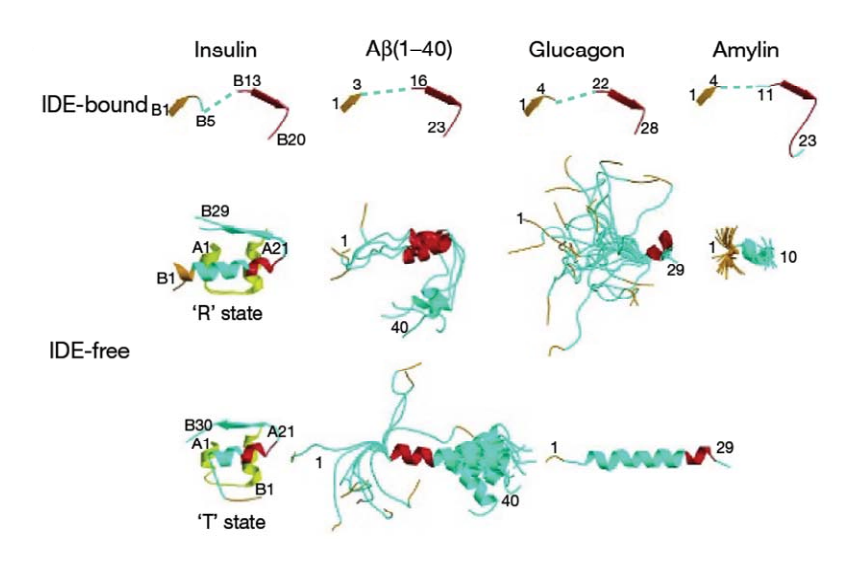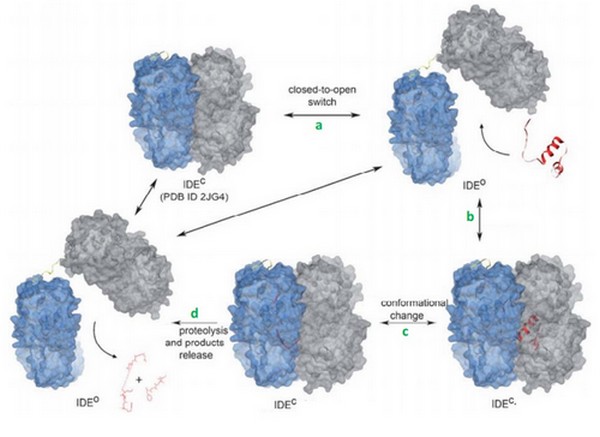Insulin Degrading Enzyme (or IDE [1]) plays an important role in the cellular degradation of many molecules. Its activity was first related only to insulin, but now, we know that IDE interacts with insulin, glugacon and bradykinin.
The IDE-bradykinin complex has a complexity in the substrate binding and recognition mechanism of IDE.
Insuline degrading enzyme
(EC 3.4.24.56) is a human enzyme of the metallopeptidase family. It is composed by more than 1000 residues and has a huge catalytic cavity. It is made of 2 parts linked by a loop, and it switches between an open and a close state. The size of its catalytic chamber allows the binding of peptides (70 amino acids long). IDE hydrolyzes a lot of substrates which have many differents biological activities. Its substrate can be insuline, glucagon, amyline or bradykinin. This enzyme hydrolyses its substrates by cleaving them at different points.
Exosite: an essential element for the catalysis
Previous studies reveal that IDE uses an exosite to interact with the N-terminal end of its substrate[1]. This exosite is completely different from the catalytic site, but it is an essential component for the substrate hydrolysis. Actually, it plays a role in the docking of substrates on IDE. Actually, when substrates arrive, they first bind to the exosite and then, they are translocated to the catalytic site. They have to change their conformation[2] in order to access to the catalytic site. It was also observed that the binding of bradykinin occurs at the exosite and not the catalytic site.

Catalytic mechanism
IDE can switch between its open and its close state. In the close state, IDE can not bind a substrate but it can hydrolyze it if it was already binding. On the other hand, in the open state, IDE can bind a substrate but it is less active because the catalytic site is not completely closed.
The catalytic mechanism occurs in 4 steps. First, IDE changes its state from close to open. This permitts the binding of the substrate in the catalytic chamber. Then, the IDE-substrate complex changes into close conformation. The substrate can now bind to the exosite with his N-term tail and then change his conformation in order to be acceptable for the catalytic site. IDE can now cleave the substrate. Once the reaction is ending, IDE changes into open conformation and release the products.

Bradykinin
is a short lived vasoactive nonapeptide mediator of the family of kinins. It's secreted in response to an inflammatory envent and serves as a mediator of pain, inflammation and vasodilatation. It is secreted by the enzymatic action of kallikreins on kininogen precursors. Kallidin is a produt of the enzymatic action of kallikrein on kininogens. Then Kallidin is transformed into bradykinin
Today, we know that kinins can be degraded by IDE.
Recognition and interactions between bradykinin and IDE
IDE can bind many substrates to its exosite and must recognize them. In order to accomplish this task, IDE uses many tools.
First, the lenght of the substrate peptide is essential. The peptide must be long enough to touch both the exosite and the catalytic site. Second, the peptide must be short enough in order to enter the catalytic chamber. In the case of the bradykinin, the length is too small to touch the catalytic site when it binds the exosite.
Song et al[3] have shown that bradykinin is too small to bind both at the exosite and the catalytic side. They prooved that IDE binds 2 bradykinin at the same time : the first one interacts with the exosite and the second one touches the catalytic site. The bradykinin in the catalytic site is the one which is going to be cleaved by the enzyme.
IDE catalytic site has a high affinity for hydrophobic and basic. Bradykinin is essentially composed by proline and arginine, which are basic amino acids. So, bradykinin structure may explain this strange interaction.
Crystal structure revealed that and of IDE are involved in interactions with bradykinin.
N-ter 3 residues of bradykinin () is also found to interact with the exosite.
The degradation of kinins and specially bradykinin is not well understand yet. The cleavage site of bradykinin by IDE, the detailed kinetic analysis and the structural basis for recognition have to be more studied.
Hypothetical role of bradykinin on IDE
Bradykinin is well known as an activator of IDE (34). Consequently, the binding of one bradykinin at the exosite must have an influence on the binding of other substrates. Actually, small peptides like bradykinin can reduce the catalytic chamber by the binding to the exosite. This leads to an increase of the binding of other substrates and the subsequent cleavage by IDE. Alternatively, bradykinin binding could reduce the cleavage by interfering with substrate binding.
Today, we can supposed that binding of bradykinin at the exosite stimulated the conformationnal change of IDE, from its open to its close state. Binding of bradykinin or other short peptides to the exosite could play a regulatory role in substrate binding and cleavage by IDE[4].
Im et al[5] suggested that ATP increases the activtity of IDE with its small substrates like braydkinin.


